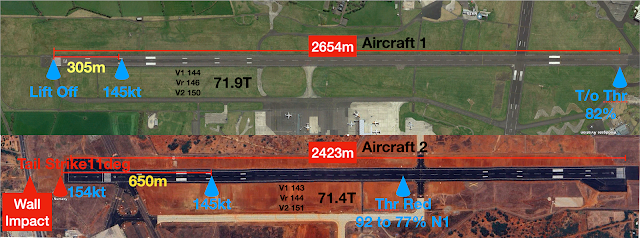In take-off, the aeroplane accelerates from zero ground speed (but not necessarily zero airspeeds!) to a speed at which it can lift itself from the ground. The thrust must exceed drag for acceleration to take place, and the lift won’t equal weight until the moment of liftoff.The plane may accelerate along the ground at a given angle of attack (or lift coefficient) until the speed reaches the point where the dynamic pressure combines with the lift coefficient to give lift equal to the weight, or it may accelerate at some angle of attack determined by its landing gear height until it reaches a speed which will give lift equals to weight when the aircraft is then rotated (tail down, nose up) to a higher angle of attack and lift coefficient.
The takeoff speed calculations are based on the assumption that one of the two engines
will be inoperative at the most critical stage of the takeoff roll. Therefore, we can assumethat the takeoff performance calculation is based on a 50% reduction of thrust at the most
critical takeoff stage.
Comparison Aircraft 1 & Aircraft 2
Aircraft 1 & 2 737-8 had similar takeoff rotation speeds of 145kts.
Aircraft 1 miscalculated the takeoff thrust and initiated the takeoff with a lower-than-required thrust by 10%.
Aircraft 2 took off with planned thrust, but, passing 120kts, there was an inadvertent 20% thrust reduction.
As per the definition of take-off speed, both aircraft should have been airborne after attaining the rotation speed of 145kt. This is keeping in mind that the aircraft's take-off performance is calculated assuming an engine failure or 50% thrust reduction after attaining the speed of V1 143,144 kts for both aircraft, respectively.
While Aircraft 1 managed to get airborne on the remaining runway, breaking only a runway end light, Aircraft 2 failed to get airborne despite pitching the nose up to 11 deg. The tail of Aircraft 2 impacted the ground beyond the runway, thereafter breaking the Localiser antennae and the top of the boundary wall, resulting in substantial damage to the aircraft.
If this intrigues you, please comment on the basic principles of flight since only one factor plays a significant role in countering lift. On reaching Vr speed, should Aircraft 2 have got airborne even with a 20% lower thrust and both engines operating? Why did Aircraft 2 have to roll an additional 650m or more distance before the aircraft 2 struggled to lift off?
Aircraft 2 landed at Mumbai airport where the reported weather was:
| SA | 12/10/2018 00:30-> | METAR VABB 120030Z 09005KT 2500 BR FEW100 28/25 Q1009 NOSIG=
|
Approach speed: as per Flightradar24 was 150kts but the final report calculations estimate the landing weight at 60.5T. Gross mismatch and moreover, the bags and cargo were not weighed during the investigation. In a takeoff incident, the actual weight of the aircraft is always under suspicion.
The final report states that the aircraft was loaded propery, however post the accident, the bags and cargo was not weighed after the accident which is procedurally incorrect. It is even more important in a case like this where the aircraft has failed to lift off at the calculated speed. I had written to the authorities to investigate the accident of Aircraft 2, but as expected, the authorities read the document but did not respond. In your opinion, what is the recourse as I have exhausted all options? In what way are you willing to assist me in finding the truth and deliver justice to many more crew members who have been indicted of making errors, not deliberate ones.
Boeing 737-800, G-JZHL. Dec 2021
During takeoff from Kuusamo Airport in Finland the flight crew inadvertently left the thrust
set at the 70% engine run-up setting rather than the 89% required for takeoff. The aircraft
became airborne with 400 m of runway remaining and climbed away slowly. At 250 ft agl
the flight crew realised they had insufficient thrust and applied the correct power. The flight
continued without further incident.
Other such incidents since 2017.
None of the above ended up in an accident.
Looking forward.










Comments
Post a Comment